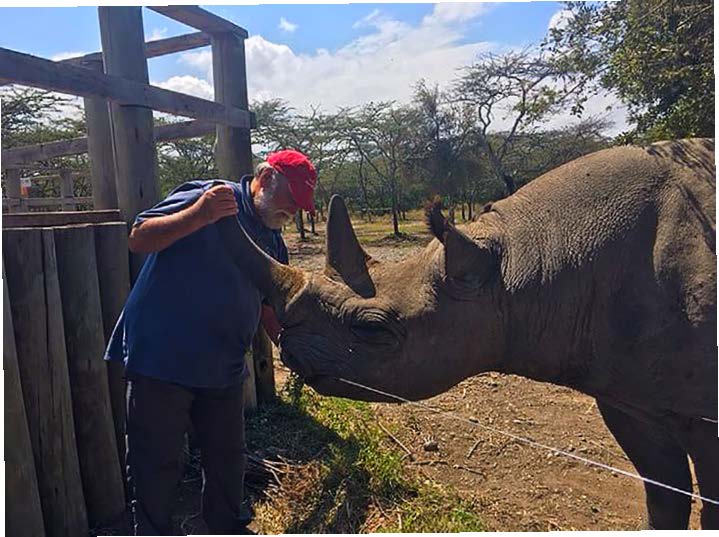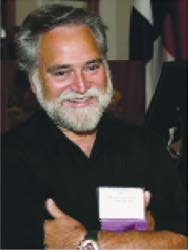ANCORA IMPARO
RICK RADER, MD ■ EDITOR-IN-CHIEF
On Being Touched by a Rhino
It is sad that humans often need a first-hand experience with someone with a disability to "get it." But perhaps that is what it takes. And if so, that provides the justification to aspire to an "inclusive society," one that exists so that "getting it" becomes natural, desirable and commonplace.
The estimated number of animal species on our planet falls somewhere in the vast range of three to 30 million.
For my money, the one animal that is the most formidable, intimidating and imposing is the rhinoceros. No other animal appears to be a direct left over from the dinosaurs. They weigh over 2,000 pounds, have thick and protective skin, and have one or two horns. The front horn on the black and white rhinos can grow to 20 to 51 inches while the rear horn can grow to about 20 inches. To say they know how to use them is an understatement. They can reach speeds of over 30 mph. The largest rhino species is the white rhino, it grows to 13 feet and weighs around 5,000 (think of an SUV).
They are indeed formidable, intimidating and imposing. They are also endangered.
There is a mythology about the powers inherent in their horns. The rhinos are killed and their horns are sold to dealers who grind the horns into powder for "magic medi cinals." It is estimated that there were 500,000 rhinos across Africa and Asia at the beginning of the 20th century. Today there are 29,000 rhinos in the wild. Some of the species of the rhino are headed for extinction. In Kenya's Ol Pejeta Rhino Sanctuary, Najin and Fatu are only two northern white rhinos left in the world, and since they are both females, despite efforts at artificially inseminating them with southern white rhino sperm, they will probably be lost forever.
Richard Vigne, Managing Director of the Ol Pejeta Rhino Sanctuary shared, "Ol Pejeta is saddened that we are now down to the last two northern white rhinos on the planet, a testament to the profligate way the human race continues to interact with the natural world around us. However, we are also immensely proud to be part of the groundbreaking work which is now being deployed to rescue this species. We hope it signals the start of an era where humans finally start to understand that proper stewardship of the environment is not a luxury but a necessity."

HORN OF AFRICA: While I jumped at the chance to touch Barracka I was a little skeptical. He was after all a black rhino and, despite his docile history, the large posted warning signs attesting to the unpredictability of animals served as a reminder that this was not a Disney animatronic display.
In my role as a member of the Global Medical Advisory Committee at Special Olympics International, I recently attended our annual meeting in Nairobi. Following the meeting I, along with several of my colleagues, took advantage of going on a safari tour to several bush campsites. Part of this "trip of a lifetime" was to actually see Africa's "Big Five." We were fortunate to see lions, elephants, rhinos, cape buffalos and the elusive leopards. The operative word is "see" them, from the safety of being in a Land Cruiser and under the guidance of our tracker and driver. Seeing them can be both life changing and life lifting. What was especially impressive was watching vast herds of wildebeests crossing the river in an expansive migration. Sitting in the open Land Cruiser it was obvious that in a different setting we (you and I) are incredibly insignificant; this was both humbling and soothing.
No one expects to touch a rhino any more than one would expect to touch an electric fence. Touching both would be fool hearty and suicidal. But I did and I doubt I will ever be the same. The Ol Pejeta Rhino Sanctuary in Kenya is dedicated to protecting the dwindling number of rhinos. It provides a safe haven to over 100 rhinos in an area that offers them the opportunity to behave and live as free roaming rhinos. The sanctuary is not to be confused with a zoo, or game park (a la Florida); it is a true sanctuary that offers protection from poachers. It guarantees a natural life where the rhinos are exposed to the same conditions they have lived in for centuries.
It is also the home to Barracka, the black rhino that tolerated my touch. In Ol Pejeta ry, the large posted warning signs attesting to the unpredictability of animals served as a reminder that this was not a Disney animatronic display. Our guide gave me a handful of grass Barracka is a celebrity. He is 24 years old and has been at the sanctuary for the last 12 years. He is perhaps the only rhino in the world that can be touched by a human.
Barracka is blind.
Barracka lost his right eye in a fight with another rhino. Having one eye in a species that normally has limited vision is a hindrance for survival. Barracka's loss of vision in one eye was noticed by the park rangers and he was brought to the sanctuary to insure his survival. Out in the bush he would not have survived. In the sanctuary Barracka acted and conducted himself like any other rhino until he lost the vision in his other eye due to cataracts. The vets tried to restore his vision with cataract surgery on several occasions but were unsuccessful.
It was when Barracka became totally blind that his life changed. He is now required to live in a smaller secure environment where his food was readily available. He also became docile and allowed the rangers to approach him, touch him and feed him his favorite grass.
Our guide asked me if I would like to touch him. While I jumped at the chance I was a little skeptical. Barracka was after all a black rhino and, despite his docile histo ry, the large posted warning signs attesting to the unpredictability of animals served as a reminder that this was not a Disney animatronic display.
Our guide gave me a handful of grass and prompted me to approach him, stand in front of him and offer the grass. While Barracka was eating from one hand I stoked his head and horn with my free hand. While I can say that I touched a rhino, the reality is that I was touched by a rhino."
While it was a gr eat opportunity I realized that it was his acquired disability that allowed me to touch him. It provided me with the realization how life changing a disabili ty can be. And while the ability to touch Barracka has been afforded to hundreds (perhaps thousands) of visitors, and in turn educated them on the plight of this endangered species, and even inspired them to become advocates, it is unfortunate that it required a disabling condition to mediate it.
It is sad that humans often need a firsthand experience with someone with a disability to "get it." But perhaps that is what it takes. And if so, that provides the justification to aspire to an "inclusive society," one that exists so that "getting it" becomes natural, desirable and commonplace. It is noteworthy that Barracka in Swahili means "blessing." He deserves the name.•
ANCORA IMPARO
In his 87th year, the artist Michelangelo (1475 -1564) is believed to have said "Ancora imparo" (I am still learning). Hence, the name for my monthly observations and comments. – Rick Rader, MD, Editor-in-Chief, EP Magazine Director, Morton J. Kent Habilitation Center Orange Grove Center, Chattanooga, TN
